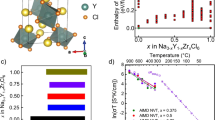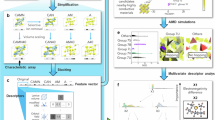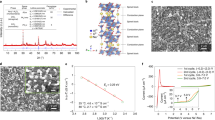Abstract
Solid-state sodium (Na) batteries open the opportunity for more sustainable energy storage due to their safety, low cost and high energy density. Inorganic solid electrolytes show notable advantages for such technologies but suffer from poor interfacial compatibility, rendering hybrid solid–liquid electrolytes an alternative. Here we show that the interfacial failure in the hybrid electrolyte system (Na3Zr2Si2PO12 (NZSP) and 1 M NaClO4 in propylene carbonate/ethylene carbonate/fluoroethylene carbonate) is closely associated with Na vacancies on the surface of NZSP. Asymmetric kinetics of solid and liquid electrolytes lead to the formation of Na vacancies and an unstable environment in the Helmholtz layer, while the organic molecules (propylene carbonate) are energetically favourable towards undesirable dehydrogenation. To eliminate the Na vacancies layer, we designed an ion-anchoring interlayer that serves to minimize the interfacial polarization. The unique O–Na coordination between the interfacial layer and NSZP confers stability to the solid–liquid interface. As demonstrated, the sodium battery with the modified hybrid electrolyte sustains 50,000 cycles with capacity retention of 86.3%. Our work provides a new path for the design of solid-state Na batteries, highlighting their potential for widespread practical applications.
This is a preview of subscription content, access via your institution
Access options
Access Nature and 54 other Nature Portfolio journals
Get Nature+, our best-value online-access subscription
$32.99 / 30 days
cancel any time
Subscribe to this journal
Receive 12 digital issues and online access to articles
$119.00 per year
only $9.92 per issue
Buy this article
- Purchase on SpringerLink
- Instant access to full article PDF
Prices may be subject to local taxes which are calculated during checkout





Similar content being viewed by others
Data availability
The data that support the findings of this study are available on request from the corresponding author. Source data are provided with this paper (Figshare https://doi.org/10.6084/m9.figshare.28473926).
References
Trost, J. N. & Dunn, J. B. Assessing the feasibility of the Inflation Reduction Act’s EV critical mineral targets. Nat. Sustain. 6, 639–643 (2023).
Dai, T. et al. Inorganic glass electrolytes with polymer-like viscoelasticity. Nat. Energy 8, 1221–1228 (2023).
Li, Y. et al. Interfacial engineering to achieve an energy density of over 200 Wh kg−1 in sodium batteries. Nat. Energy 7, 511–519 (2022).
Zhou, S. et al. Printed solid-state batteries. Electrochem. Energy Rev. 6, 34 (2023).
Lee, M. J. et al. Elastomeric electrolytes for high-energy solid-state lithium batteries. Nature 601, 217–222 (2022).
Liu, Q., Chen, Q., Tang, Y. & Cheng, H.-M. Interfacial modification, electrode/solid-electrolyte engineering, and monolithic construction of solid-state batteries. Electrochem. Energy Rev. 6, 15 (2023).
Randau, S. et al. Benchmarking the performance of all-solid-state lithium batteries. Nat. Energy 5, 259–270 (2020).
Yu, Z. et al. Dendrites in solid-state batteries: ion transport behavior, advanced characterization, and interface regulation. Adv. Energy Mater. 11, 2003250 (2021).
Chen, X. & Vereecken, P. M. Solid and solid-like composite electrolyte for lithium ion batteries: engineering the ion conductivity at interfaces. Adv. Mater. Interfaces 6, 1800899 (2018).
Yan, Y. et al. Bioinspired design of Na-ion conduction channels in covalent organic frameworks for quasi-solid-state sodium batteries. Nat. Commun. 14, 3066 (2023).
Liu, M. et al. Improving Li-ion interfacial transport in hybrid solid electrolytes. Nat. Nanotechnol. 17, 959–967 (2022).
Huo, H. & Janek, J. Solid-state batteries: from ‘all-solid’ to ‘almost-solid’. Natl Sci. Rev. 10, nwad098 (2023).
Weiss, M. et al. From liquid- to solid-state batteries: ion transfer kinetics of heteroionic interfaces. Electrochem. Energy Rev. 3, 221–238 (2020).
Langer, F. et al. Impedance spectroscopy analysis of the lithium ion transport through the Li7La3Zr2O12/P(EO)20Li interface. J. Electrochem. Soc. 164, A2298–A2303 (2017).
Huang, L. et al. Negating Li+ transfer barrier at solid–liquid electrolyte interface in hybrid batteries. Chem 8, 1928–1943 (2022).
Busche, M. R. et al. Dynamic formation of a solid–liquid electrolyte interphase and its consequences for hybrid-battery concepts. Nat. Chem. 8, 426–434 (2016).
Oh, D. Y. et al. Slurry‐fabricable Li+‐conductive polymeric binders for practical all‐solid‐state lithium‐ion batteries enabled by solvate ionic liquids. Adv. Energy Mater. 9, 1802927 (2019).
Janek, J. & Zeier, W. G. Challenges in speeding up solid-state battery development. Nat. Energy 8, 230–240 (2023).
Liu, J. et al. The interface between Li6.5La3Zr1.5Ta0.5O12 and liquid electrolyte. Joule 4, 101–108 (2020).
Wang, X., Chen, J., Wang, D. & Mao, Z. Improving the alkali metal electrode/inorganic solid electrolyte contact via room-temperature ultrasound solid welding. Nat. Commun. 12, 7109 (2021).
Deng, Z. et al. Fundamental investigations on the sodium-ion transport properties of mixed polyanion solid-state battery electrolytes. Nat. Commun. 13, 4470 (2022).
Goodenough, J. B., Hong, H. Y. P. & Kafalas, J. A. Fast Na+-ion transport in skeleton structures. Mater. Res. Bull. 11, 203–220 (1976).
Zhang, Z. et al. A self‐forming composite electrolyte for solid‐state sodium battery with ultralong cycle life. Adv. Energy Mater. 7, 1601196 (2016).
Zhang, Z. et al. Correlated migration invokes higher Na+‐ion conductivity in NaSICON‐type solid electrolytes. Adv. Energy Mater. 9, 1902373 (2019).
Weiss, M. et al. Unraveling the formation mechanism of solid–liquid electrolyte interphases on LiPON thin films. ACS Appl. Mater. Interfaces 11, 9539–9547 (2019).
Chen, L. et al. PEO/garnet composite electrolytes for solid-state lithium batteries: from ‘ceramic-in-polymer’ to ‘polymer-in-ceramic’. Nano Energy 46, 176–184 (2018).
Li, Z. et al. Ionic conduction in composite polymer electrolytes: case of PEO:Ga-LLZO composites. ACS Appl. Mater. Interfaces 11, 784–791 (2018).
Jung, Y.-C. et al. All solid-state lithium batteries assembled with hybrid solid electrolytes. J. Electrochem. Soc. 162, A704–A710 (2015).
Park, M.-S., Jung, Y.-C. & Kim, D.-W. Hybrid solid electrolytes composed of poly(1,4-butylene adipate) and lithium aluminum germanium phosphate for all-solid-state Li/LiNi0.6Co0.2Mn0.2O2 cells. Solid State Ion. 315, 65–70 (2018).
Isaac, J. A., Devaux, D. & Bouchet, R. Dense inorganic electrolyte particles as a lever to promote composite electrolyte conductivity. Nat. Mater. 21, 1412–1418 (2022).
MacFarlane, D. R., Newman, P. J., Nairn, K. M. & Forsyth, M. Lithium-ion conducting ceramic/polyether composites. Electrochim. Acta 43, 1333–1337 (1998).
Mehrotra, A., Ross, P. N. & Srinivasan, V. Quantifying polarization losses in an organic liquid electrolyte/single ion conductor interface. J. Electrochem. Soc. 161, A1681–A1690 (2014).
Zarrabeitia, M. et al. Towards environmentally friendly Na-ion batteries: moisture and water stability of Na2Ti3O7. J. Power Sources 324, 378–387 (2016).
Sagane, F., Abe, T., Iriyama, Y. & Ogumi, Z. Li+ and Na+ transfer through interfaces between inorganic solid electrolytes and polymer or liquid electrolytes. J. Power Sources 146, 749–752 (2005).
Sagane, F., Abe, T. & Ogumi, Z. Sodium-ion transfer at the interface between ceramic and organic electrolytes. J. Power Sources 195, 7466–7470 (2010).
Sun, N. et al. Anisotropically electrochemical–mechanical evolution in solid-state batteries and interfacial tailored strategy. Angew. Chem. Int. Ed. 58, 18647–18653 (2019).
Wang, J., Chen‐Wiegart, Y. C. K. & Wang, J. In situ three‐dimensional synchrotron X‐ray nanotomography of the (de)lithiation processes in tin anodes. Angew. Chem. Int. Ed. 53, 4460–4464 (2014).
An, H. et al. Eliminating local electrolyte failure induced by asynchronous reaction for high-loading and long‐lifespan all‐solid‐state batteries. Adv. Funct. Mater. 33, 2305186 (2023).
Huo, H. et al. Li2CO3 effects: new insights into polymer/garnet electrolytes for dendrite-free solid lithium batteries. Nano Energy 73, 104836 (2020).
Lu, X. et al. Microstructural evolution of battery electrodes during calendering. Joule 4, 2746–2768 (2020).
Liu, Q.-S. et al. Effective transport network driven by tortuosity gradient enables high-electrochem-active solid-state batteries. Natl Sci. Rev. 10, nwac272 (2023).
Chang, Q. et al. Investigation on interfacial interaction and the origin of Fe3+ in LiFePO4/C. Electrochim. Acta 108, 211–218 (2013).
Yoon, W.-S. et al. Oxygen contribution on Li-ion intercalation–deintercalation in LiAlyCo1−y O2 investigated by O K-edge and Co L-edge X-ray absorption spectroscopy. J. Electrochem. Soc. 149, A1305 (2002).
He, R. et al. Soft X-ray irradiation effects of Li2O2, Li2CO3 and Li2O revealed by absorption spectroscopy. PLoS ONE 7, e49182 (2012).
Zhang, Z. et al. Na3Zr2Si2PO12: a stable Na+-ion solid electrolyte for solid-state batteries. ACS Appl. Energy Mater. 3, 7427–7437 (2020).
Zhai, Y. et al. A hybrid solid electrolyte for high-energy solid-state sodium metal batteries. Appl. Phys. Lett. 120, 253902 (2022).
Hou, M. et al. Multiscale investigation into chemically stable NASICON solid electrolyte in acidic solutions. ACS Appl. Mater. Interfaces 13, 33262–33271 (2021).
Lu, Z. et al. Electrolyte sieving chemistry in suppressing gas evolution of sodium‐metal batteries. Angew. Chem. Int. Ed. 61, e202206340 (2022).
Gu, Z. et al. Atomic-scale study clarifying the role of space-charge layers in a Li-ion-conducting solid electrolyte. Nat. Commun. 14, 1632 (2023).
Xu, J. et al. Electrolyte design for Li-ion batteries under extreme operating conditions. Nature 614, 694–700 (2023).
Li, C. et al. NaSICON: a promising solid electrolyte for solid‐state sodium batteries. Interdiscip. Mater. 1, 396–416 (2022).
Wang, X. et al. Constructing interfacial nanolayer stabilizes 4.3 V high‐voltage all‐solid‐state lithium batteries with PEO‐based solid‐state electrolyte. Adv. Funct. Mater. 32, 2113068 (2022).
Zhou, D. et al. Polymer electrolytes for lithium-based batteries: advances and prospects. Chem 5, 2326–2352 (2019).
Su, Y. et al. Cryo-TEM studies of binder free high performance FeF2 cathode based full cells enabled by surface engineering. Energy Storage Mater. 59, 102779 (2023).
Xie, M. et al. Pathway of in situ polymerization of 1,3-dioxolane in LiPF6 electrolyte on Li metal anode. Mater. Today Energy 21, 100730 (2021).
Fu, C. et al. Molecular bridges stabilize lithium metal anode and solid-state electrolyte interface. Chem. Eng. J. 432, 134271 (2022).
Li, M. et al. Ion–dipole-interaction-induced encapsulation of free residual solvent for long-cycle solid-state lithium metal batteries. J. Am. Chem. Soc. 145, 25632–25642 (2023).
Mi, J. et al. Topology crafting of polyvinylidene difluoride electrolyte creates ultra-long cycling high-voltage lithium metal solid-state batteries. Energy Storage Mater. 48, 375–383 (2022).
Song, Y. et al. Highly reversible solid‐state lithium‐oxygen batteries by size‐matching between Fe‐Fe cluster and Li2‐xO2. Adv. Energy Mater. 13, 2203660 (2022).
Ma, J. et al. A strategy to make high voltage LiCoO2 compatible with polyethylene oxide electrolyte in all-solid-state lithium ion batteries. J. Electrochem. Soc. 164, A3454–A3461 (2017).
Wang, H. et al. Thiol‐branched solid polymer electrolyte featuring high strength, toughness, and lithium ionic conductivity for lithium‐metal batteries. Adv. Mater. 32, 202001259 (2020).
Ba, D. et al. Robust cathode-ether electrolyte interphase on interfacial redox assembled fluorophosphate enabling high-rate and ultrastable sodium ion full cells. Nano Energy 94, 106918 (2022).
Wan, T. H., Lu, Z. & Ciucci, F. A first principle study of the phase stability, ion transport and substitution strategy for highly ionic conductive sodium antipervoskite as solid electrolyte for sodium ion batteries. J. Power Sources 390, 61–70 (2018).
He, K. et al. In‐situ intermolecular interaction in composite polymer electrolyte for ultralong life quasi‐solid‐state lithium metal batteries. Angew. Chem. Int. Ed. 60, 12116–12123 (2021).
Chen, R.-J. et al. Addressing the interface issues in all-solid-state bulk-type lithium ion battery via an all-composite approach. ACS Appl. Mater. Interfaces 9, 9654–9661 (2017).
Cha, H. et al. Boosting reaction homogeneity in high‐energy lithium‐ion battery cathode materials. Adv. Mater. 32, 202003040 (2020).
Besli, M. M. et al. Mesoscale chemomechanical interplay of the LiNi0.8Co0.15Al0.05O2 cathode in solid-state polymer batteries. Chem. Mat. 31, 491–501 (2018).
Nguyen, L. H. B. et al. Stability in water and electrochemical properties of the Na3V2(PO4)2F3-Na3(VO)2(PO4)2F solid solution. Energy Storage Mater. 20, 324–334 (2019).
Acknowledgements
This work was supported by the National Natural Science Foundation of China (no. 92372110 and no. 22075063), the Chinesisch-Deutsches Mobilitätspropgamm (M-0281), the Opening Project of State Key Laboratory of Space Power-Sources, the Fundamental Research Funds for the Central Universities (grant no. HIT.OCEF.2023039), the Heilongjiang Touyan Team (no. HITTY-20190033), the ‘Young Scientist Studio’ of Harbin Institute of Technology (HIT) and funds from Chongqing Research Institute of HIT. We thank the Shanghai Synchrotron Radiation Facility (SSRF) for providing the beamlines of BL13HB, BL18B and BL08U1A for completing STXM and SR-CT measurements. Finally, we extend gratitude to E. J. Hansen from the Advanced Materials for Energy Storage Lab at the University of British Columbia (UBCO) for proofreading the manuscript.
Author information
Authors and Affiliations
Contributions
All authors have approved the final version of the manuscript. J.W. proposed the research direction and conceived and led the project. H.A. designed and performed experiments with other co-authors. M.L., Q.L. and Y.S. performed STXM and CT measurements, analysed and discussed experimental results and drafted the manuscript. B.D. aided with the synchrotron radiation data collection at the SSRF. X.L. offered access to the experimental platform and equipment for pouch cells fabrication and testing. All authors participated in discussions and contributed valuable comments.
Corresponding author
Ethics declarations
Competing interests
The authors declare no competing interests.
Peer review
Peer review information
Nature Sustainability thanks Cheng Zhang and the other, anonymous, reviewer(s) for their contribution to the peer review of this work.
Additional information
Publisher’s note Springer Nature remains neutral with regard to jurisdictional claims in published maps and institutional affiliations.
Supplementary information
Supplementary Information
Supplementary Figs. 1–44 and Tables 1–6.
Rights and permissions
Springer Nature or its licensor (e.g. a society or other partner) holds exclusive rights to this article under a publishing agreement with the author(s) or other rightsholder(s); author self-archiving of the accepted manuscript version of this article is solely governed by the terms of such publishing agreement and applicable law.
About this article
Cite this article
An, H., Li, M., Liu, Q. et al. Hybrid electrolyte enables solid-state sodium batteries sustaining 50,000 cycles. Nat Sustain 8, 661–671 (2025). https://doi.org/10.1038/s41893-025-01544-6
Received:
Accepted:
Published:
Issue date:
DOI: https://doi.org/10.1038/s41893-025-01544-6



